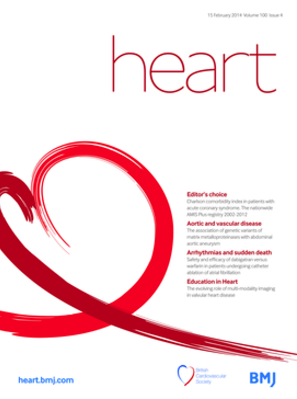摘要
背景和目的:在一级预防中,小剂量阿司匹林可减少约 11% 的主要血管事件 (MVE),但会增加 40-50% 的主要出血 (MB),这意味着当 MVE 与 MB 的比率大于 4 时,净获益最为明显。 本研究旨在得出 MB 和 MVE 的交叉验证风险评分,并使用 MVE 与 MB 的比率来识别可能从治疗中获得不同净获益的群体。方法:对 431 167 名基线时未发现动脉粥样硬化性心血管疾病的英国生物样本库参与者进行了跟踪调查,通过记录链接发现了 MVE(心肌梗死、非出血性中风、短暂性脑缺血发作、动脉血管再通术或血管性死亡)和 MB(入院时间≥2 天的胃肠道出血和颅内出血)事件。MVE 和 MB 的风险评分是通过交叉验证的 Cox 比例危险模型得出的。计算了不同风险类别中观察到的 MVE 与 MB 发生率之比:结果:在中位数为 12 年的随访期间,18 310 名参与者发生了 MVE,5352 名参与者发生了 MB。患有虚弱、既往出血、癌症、肝病或肾功能障碍的参与者发生 MB 的风险最高,MB 风险最高的五分之一和最低的五分之一之间的风险相差 4.3 倍(HR 4.3,95% CI 3.87 至 4.77)。在 MB 风险最高的组别中,MVE 与 MB 的比值≤2.6,而在 MB 风险较低的组别中,MVE 与 MB 的比值≥4:结论:与使用包括血管风险因素在内的传统 MB 风险模型相比,使用常规疾病史和实验室测量得出的模型可提高 MVE 与 MB 比值的区分度。这些模型有助于识别中度 MVE 风险但 MB 风险较低的人群,他们可能会从小剂量阿司匹林中获益。Background and aims: In the primary prevention setting, low-dose aspirin reduces major vascular events (MVEs) by approximately 11% but increases major bleeding (MB) by 40-50%, implying that net benefit will be most evident when the MVE-to-MB ratio is >4. This study aimed to derive cross-validated risk scores for MB and MVE and use the MVE-to-MB ratio to identify groups who may derive differing net benefits from treatment.
Methods: 431 167 UK Biobank participants without known atherosclerotic cardiovascular disease at baseline were followed through record linkage for incident MVEs (myocardial infarction, non-haemorrhagic stroke, transient ischaemic attack, arterial revascularisation or vascular death) and MB (gastrointestinal and intracranial bleeds with hospital admission for ≥2 days). Risk scores were derived for MVE and MB using Cox proportional hazards models with cross-validation. Ratios of observed MVE-to-MB rates were calculated across risk categories.
Results: During a median follow-up of 12 years, 18 310 participants suffered an MVE and 5352 an MB. MB risk was highest among participants with frailty, prior bleeds, cancer, liver disease or renal dysfunction, with a 4.3-fold difference in risk between the highest and lowest fifths of MB risk (HR 4.3, 95% CI 3.87 to 4.77). The MVE-to-MB ratio was ≤2.6 in the highest MB risk groups and ≥4 in lower MB risk categories.
Conclusions: The derived models using routinely available disease history and laboratory measurements improved distinction of the MVE-to-MB ratio compared with using conventional models for MB risk including vascular risk factors. Such models can help identify those with moderate MVE risk but low MB risk who may benefit from low-dose aspirin.

 求助内容:
求助内容: 应助结果提醒方式:
应助结果提醒方式:


